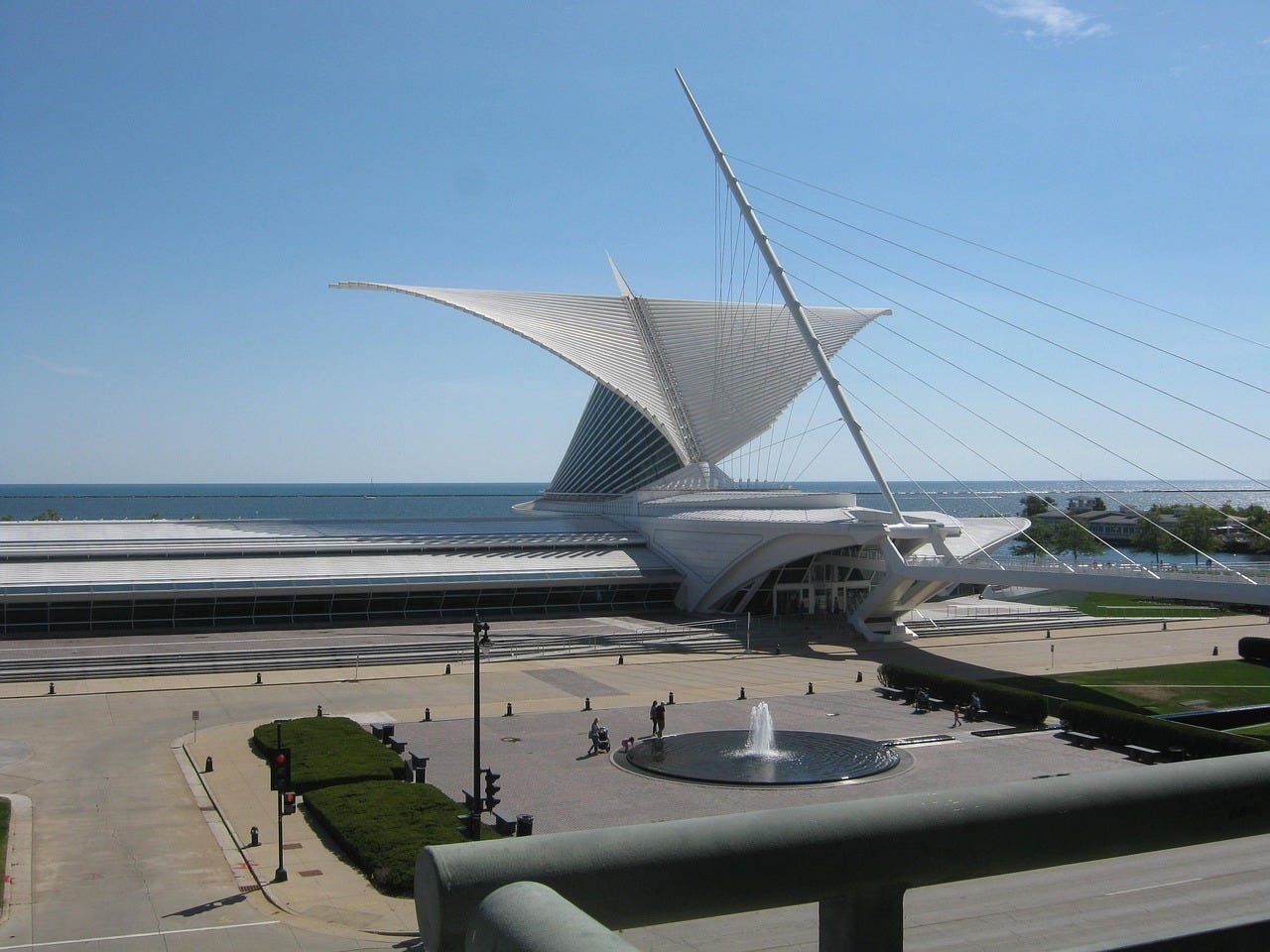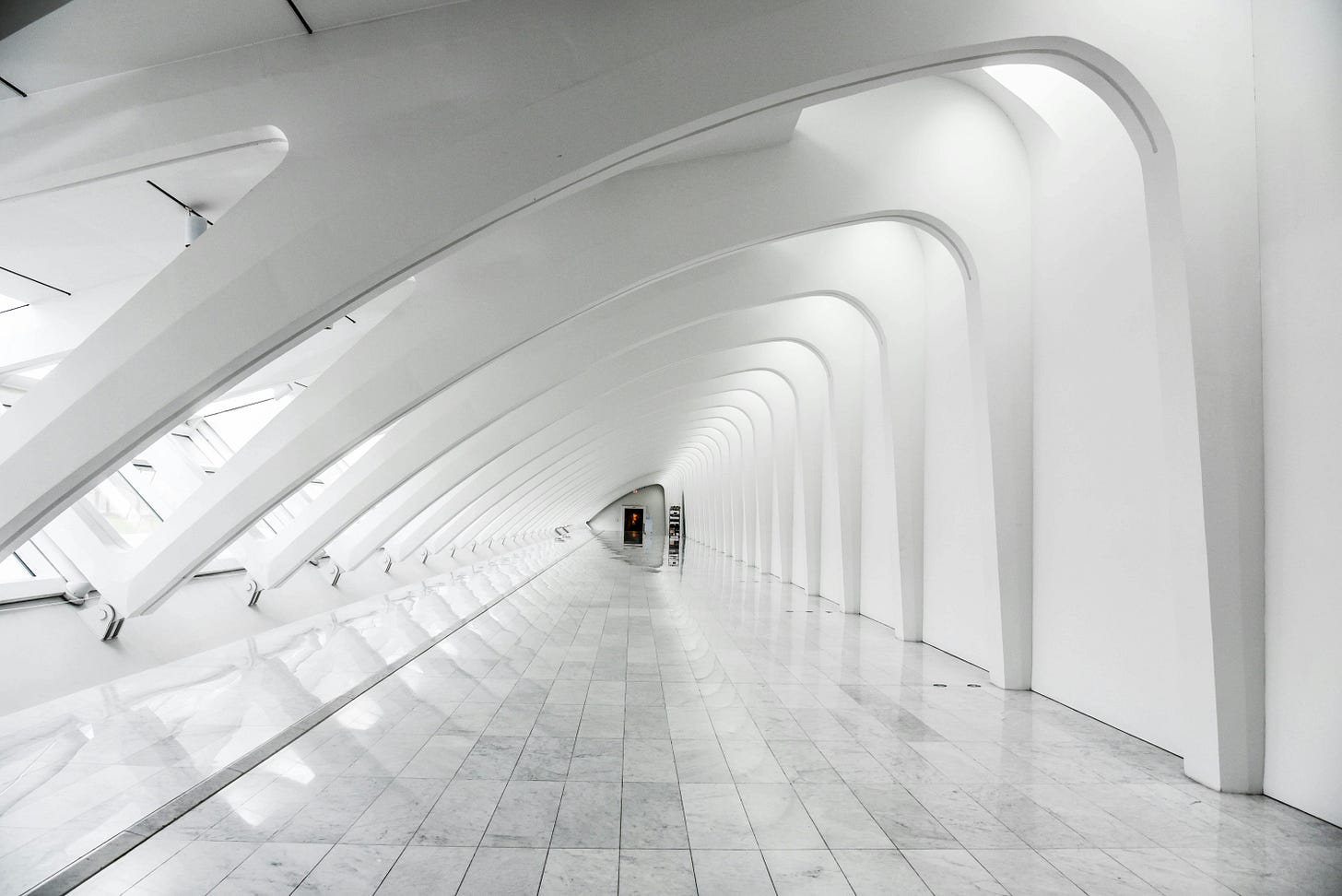The first time I’ve visited the Milwaukee Art Museum (MAM), I stood there, in the walkway for a long few minutes to take in the impressive view in front of me. My disbelief, amazement, and awe was hardly something I could put into words. This post might be a boring reading for you if architecture is not your thing or something you have not come to appreciate yet. For me however, architecture is the perfect blend between sculpture, art, and function. As you probably remember, I had mentioned before my affection for architecture.
While I was preparing for one of my Art Appreciation lectures, I had an epiphanic question: when does architecture become sculpture or when does sculpture become architecture? Delighted as I was with my epiphany, I was as intensely sad to discover many others have explored this angle. Hence, I went into a self doubting episode about whether or not it was worth writing about it. You know, as one does when plans are deflated.
Nonetheless, it occurred to me that my unique fascination with architecture and how the MAM impacted me was something worth penning. To my surprise, every time I mention the architect, the one and only Santiago Calatrava, I find blank stares. Frank Lloyd Wright, almost everyone knows. Others like Frank Gehry, Zaya Hadid, Bjarke Ingels, to mention a few, not many know despite of their work being internationally known. Though to be fair, Gehry is much more known. Gehry designed the Guggenheim Bilbao which is considered one of the most important buildings in the 20th century.
So, you might be thinking, okay, out with it! What makes Calatrava such a wonder in your mind? Oh! So many things!! But if you have never visited MAM, please do yourself a favor and book a ticket or drive to MAM. The building’s wings, which I will explain in a moment, remain close now for repairs. You might want to wait a little.
My MFA thesis focused on body movement and the shapes a dancing body makes in the space. Now, I know we can discuss whether these shapes are forms or shapes. The body is of course, three dimensional and thus, when the body moves it creates forms. But, if you consider that when the body moves, you are only seeing its front, it could be said that if you take the space and the body at face value to strip your mind of the ideas of depth and mass, the body is simply a moving line interacting with the space. After all, when you take a photo, or draw a sketch of said body in motion, it would be a series of shapes, not forms. The idea of volume, mass, and depth would be communicated through the stylization of said lines and shapes. I know, I know, I am geeking. But this is so good!!
Because of the above background I explained, when I came across the MAM I could not fathom that a building with its massive structures could posses a set of wings that open and close and thus interact with the space. To be precise, the building faces Lake Michigan and it kind of looks both like a bird taking flight or a cruise ship facing the massive body of water. I am writing this and I can barely contain my excitement. See a picture below taken by Leonardo Marchini.
When you enter the space right under the wings, it gets flooded with light. Since the walls are also white, it is like being immersed in a bath of light caressing the space. When you think about how these heavy wings open and close, one has to wonder about the capacity of this architect to imagine materials that are usually conceived in a vertical or horizontal directions, to move and defy gravity and the materials themselves. It is a testament to his curiosity and intellect. See picture by gdtography below of one of the angles.
The moment I saw the wings, I saw movement. As I started researching Calatrava’s work, I found out that he sketches bodies in motion. The book by Alexander Tzonis titled Santiago Calatrava: The Complete Works, shows some of Calatrava’s sketches of bodies in motion. According to Tzonis, these drawings are sketched under a framework invented by Goya of the “five points” exercise. Tzonis explains how the artist needs to imagine a figure within these five points (I imagine the points would be in various areas within an invisible constrained shape).
That was my hook. I did not know about the exercise when I saw the MAM but I could see the movement, the flow, the energy, and the grace within the structure. The book records Calatrava’s words about why he wanted to study architecture:
I am interested in drawing.
I always felt excitement for artistic matters.
I think I have the capabilities for the study and development of this profession.
I have hopes for this career and I expect that with my work and resilience I will surmount the weaknesses in education and abilities that I have now.
But, only the freehand sketching of bodies in motion or organic shapes would not be enough to crystallize the massive interactions of heavy materials in space. Calatrava taught himself to draw geometrically and to use perspective. Thus, in this exploration another one surfaced: how to design structures that move but remain joined together at one point or points. As I type this I think of the fingers and the hand. These limbs fold, move, expand, all while being joined at the palm.
Yes, Calatrava has been known for going over budget in considerably large amounts. But so has Gehry’s. And they have gone through lawsuits over contract issues. When you look at the immensity of their work, of Calatrava’s work, I mean, one can’t help but be in awe of the ingenuity to defy and challenge traditions, conventions, and expectations. At least, I am and remain in awe.
Movement in static contexts has always captivated me. The flow of shapes into the page, or into the space, the poetics of movement, and metaphors it envelops are to me a captivating mystery.
I hope this was not too boring for you. I can’t help but feel giddy and excited when I talk about work that I believe in.
Love,
Alma






